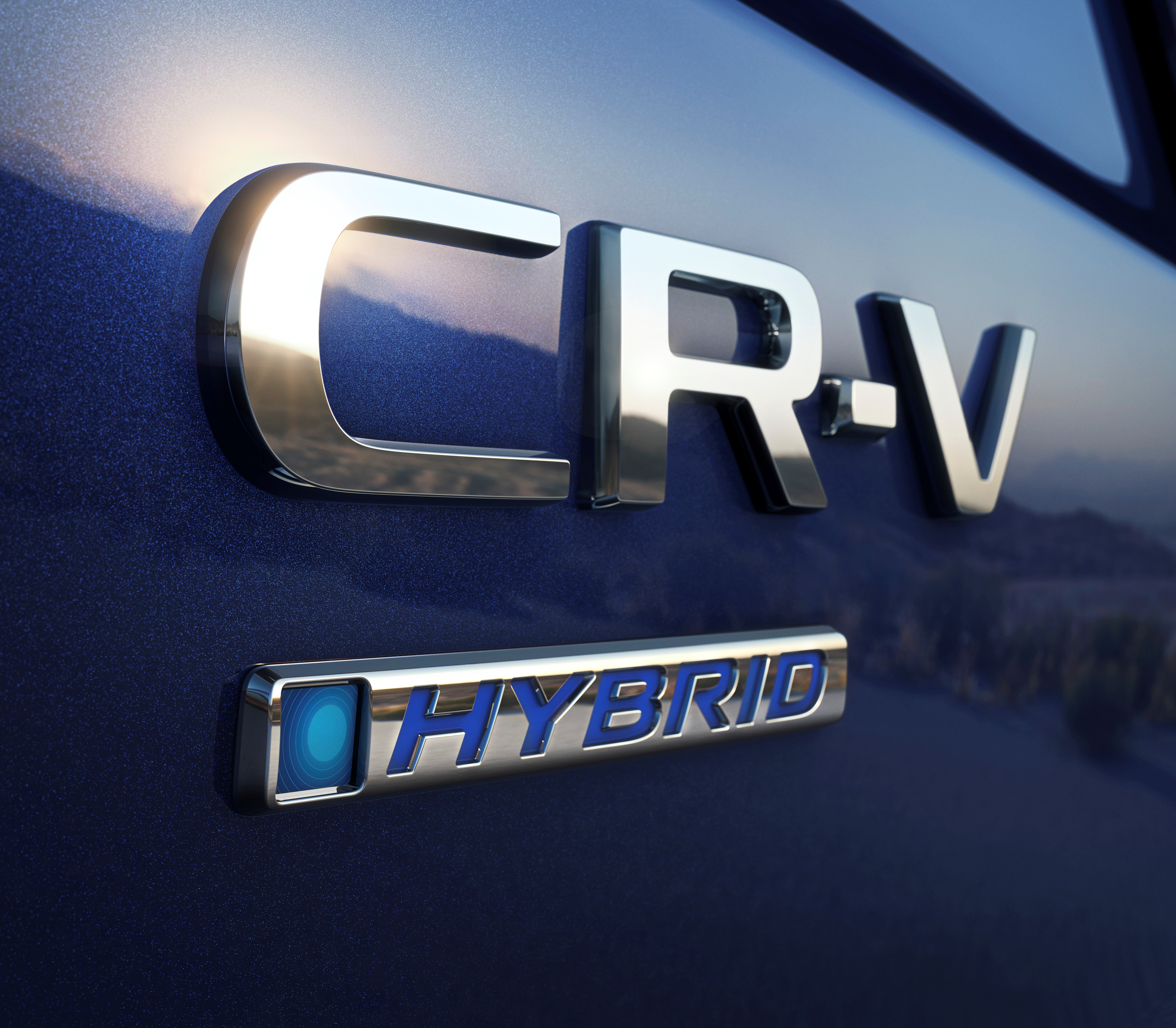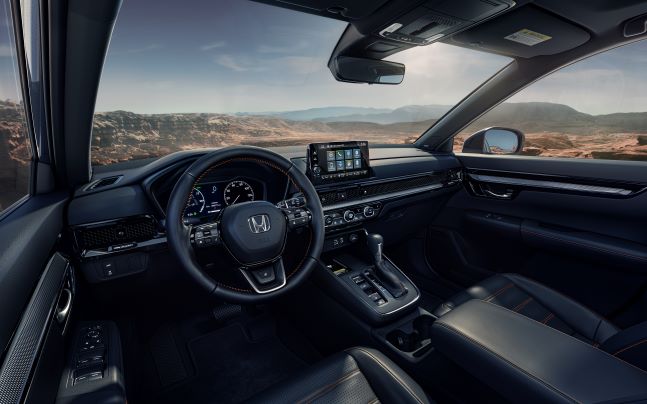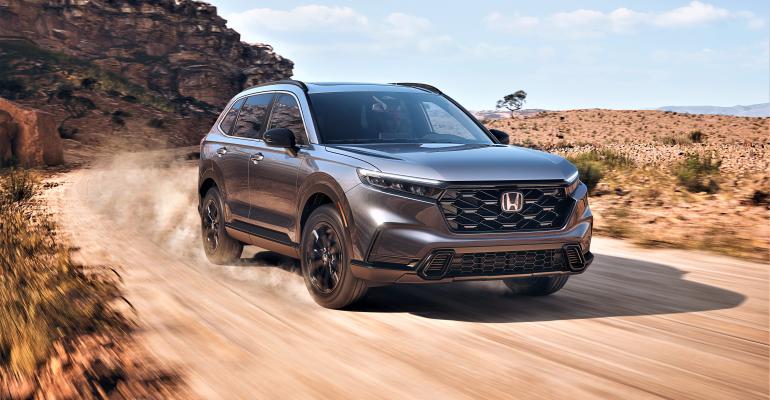Honda’s CR-V has been America’s top-selling crossover utility since 1997 and the brand’s best overall seller since 2017. The automaker says the ’22 CR-V enjoys record turn rates, with about half of them sold before they roll off the trucks at Honda dealerships.
So why launch an all-new ʼ23 sixth-generation at this time, and can Honda do that without risking such a high level of popularity? Apparently yes, by ensuring that every change, both major and minor, is a genuine improvement that will make a noticeable difference.
For starters, the new CR-V has a more rugged new look – longer and wider with a wider, more planted stance. That is backed up by a roomier interior with a claimed best-in-class second row, a larger cargo area and, more significantly, a more advanced and more powerful, yet more efficient, available 2-motor hybrid system. More on that to come.
 This ’23 CR-V is available in four trim levels, the top two of which are Sport and Sport Touring Hybrid models. Honda says the hybrids offer not just the most fuel-efficient but also the sportiest CR-V driving experience and are touted as a key step in the brand’s electrification strategy expected to represent up to 50% of annual CR-V sales.
This ’23 CR-V is available in four trim levels, the top two of which are Sport and Sport Touring Hybrid models. Honda says the hybrids offer not just the most fuel-efficient but also the sportiest CR-V driving experience and are touted as a key step in the brand’s electrification strategy expected to represent up to 50% of annual CR-V sales.
Civic and Accord Hybrids will follow, and Honda’s first all-electric BEV is promised for 2024.
Inside, the new CR-V is quieter and more comfortable with improved visibility and the most cabin and cargo space ever in a CR-V. It shares its basic design, high-quality materials and premium touches with the ’22 Civic and ’23 HR-V, and its new “Body Stabilizing” front seats are said to reduce fatigue (they worked for us) and improve posture. A digital instrument display, a 7-in. (18-cm) touchscreen audio system with Apple CarPlay and Android Auto compatibility and USB charge ports for driver and front passenger are standard. Sport Touring and EX-L models offer a 9-in. (23-cm) touchscreen with wireless phone integration and charging, and Sport and Sport Touring add two USB charge ports for rear passengers.
Beyond its updated Honda Advanced Compatibility Engineering (ACE) body structure are standard advanced active and passive safety features that include expanded and improved Honda Sensing safety and driver-assist technology with a new front sensor camera and radar system. Included are “next-gen” front airbags and new front knee and rear side-impact airbags.
Two-Motor Hybrids
Honda’s Two-Motor Hybrid system first appeared in the ’14 Accord Hybrid, and its third generation is available in ’22 Accord and CR-V Hybrids. This new ’23 CR-V debuts a smaller, lighter, more powerful and more efficient fourth-generation version as the standard (and only) powertrain in Sport and Sport Touring models. Its five core components:
- Electric generator motor – supplies power to the hybrid battery.
- Electric propulsion motor – directly drives the wheels.
- Atkinson-cycle gasoline engine – supplies power to the propulsion motor and/or the hybrid battery.
- Intelligent Power Unit (IPU) – houses the battery and its controlling hardware.
- Power Control Unit (PCU) – the system’s “brain” that controls all hybrid functions.
While the first three generations mounted their two motors in line with each other – with the generator motor connected directly to the engine and the propulsion motor to the drive wheels – this Gen IV system positions them side-by-side. This allows the use of a larger, more powerful (181-hp) propulsion motor capable of 14,500 rpm for a higher top speed and up to 247 lb.-ft. (335 Nm) of torque, 15 lb.-ft. (20 Nm) more than the previous motor.

The side-by-side arrangement also allows the use of two separate lock-up clutches and direct-drive gear sets, one for city and one for highway speeds, which allows better optimization of gas engine speeds for improved response and refinement. The low-speed lockup clutch enables engine drive at urban speeds, which improves efficiency and provides 1,000 lbs. (454 kg) of towing capacity, a first for a Honda hybrid. The high-speed lockup clutch reduces engine rpm at highway speeds and contributes to the higher top speed.
Also optimized for size and efficiency are the IPU and PCU. The IPU houses a 1.06-kWh battery and its controlling hardware in a 24% smaller, 12% lighter package, which enables ’23 CR-V Hybrid models to offer the same cargo space as their non-hybrid stablemates. The under-hood PCU is thinner than before, which allows more room in the engine compartment for improved noise management.
The system’s updated 2.0L DOHC Atkinson-cycle i-VTEC 4-cyl., now with multistage direct fuel injection, contributes 145 hp and 138 lb.-ft. of torque (187 Nm) with significantly reduced emissions: 22% less nitrogen-oxide and 24% less total hydrocarbon.
The 2023 CR-V Hybrids (available with front-wheel drive or Honda’s Real Time AWD with Intelligent Control) deliver 204 total system horsepower and are EPA rated at 43/36/40 mpg city/highway/combined (5.5/6.5/5.9 L/100 km) with FWD and 40/34/37 mpg (5.5/6.9/6.4 L/100 km) with AWD. EPA ratings for non-hybrid ’23 CR-Vs are 28/34/30 mpg (8.4/6.9/7.8 L/100 km) (FWD) and 27/32/29 mpg (8.7/7.3/8.1 L/100 km) (AWD).
Driving Impressions
We drove a ’23 Sport Touring AWD CR-V on a mix or two-lanes and freeways near Santa Barbara, CA and found it living up to its claimed improvements in almost every way. Not surprisingly (given its Civic bones), it’s an agile handler with crisp, responsive steering and strong, linear braking when needed…and we needed it more than once. It rode smoothly on lumpy surfaces and was pleasingly quiet even at elevated speeds, and the upgraded AWD system (which includes hill-descent control) can split torque an even 50/50 vs. the previous 60/40 front to rear. We also appreciated its very tight turning circle.

Our only dynamic disappointment was that – while billed as the “most powerful CR-V yet” – it didn’t feel quite as torquey and powerful as we expected. But it was noticeably stronger than the ’22 CR-V Hybrid that Honda provided for comparison and also felt quicker than the 190-hp turbocharged 1.5L non-hybrid ’23 CR-V EX-L that we tried.
Its new system offers Normal, Econ, Snow and Sport driving modes, so we used Sport for driving hard on twisty two lanes. Without active suspension, it can’t affect handling but does alter throttle and transmission response (while substantially raising the engine’s noise levels). The ʼ23 system also does a much better job than the ʼ22 of disguising the E-CVT’s annoying tendency to have the engine running at high rpm during even mild acceleration.
We found the infotainment interface mostly good, though it would be better with a handful of mode-selection hard buttons and a tune/scroll knob to complement Honda’s (recently reinstated) volume knob. A new “B” shifter selection enables 0.09g of lift-throttle regenerative braking, and steering wheel paddles can adjust that amount up or down. It’s not quite one-pedal driving, but we used and liked it during our daylong drive. Our only other gripe: without “Direct Tune” to punch in known radio stations, you need to scroll to find them.
Bottom line: There’s no reason why this feature-loaded new CR-V, and especially its more fun and efficient Hybrid models, should not do at least as well as the one it replaces.





